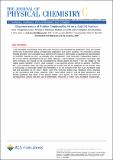Files in this item
Oligomerization of proline catalyzed by Ni on a Au(111) surface
Item metadata
| dc.contributor.author | Seljamae-Green, Riho T. | |
| dc.contributor.author | Robinson, Thomas | |
| dc.contributor.author | Fruchtl, Herbert A. | |
| dc.contributor.author | Baddeley, Christopher John | |
| dc.date.accessioned | 2020-03-27T00:32:09Z | |
| dc.date.available | 2020-03-27T00:32:09Z | |
| dc.date.issued | 2019-04-18 | |
| dc.identifier.citation | Seljamae-Green , R T , Robinson , T , Fruchtl , H A & Baddeley , C J 2019 , ' Oligomerization of proline catalyzed by Ni on a Au(111) surface ' , Journal of Physical Chemistry C , vol. 123 , no. 15 , pp. 9935-9943 . https://doi.org/10.1021/acs.jpcc.9b01004 | en |
| dc.identifier.issn | 1932-7447 | |
| dc.identifier.other | PURE: 258344652 | |
| dc.identifier.other | PURE UUID: ff5a1333-f1da-4052-976b-6c565854d817 | |
| dc.identifier.other | ORCID: /0000-0001-9750-6494/work/57330781 | |
| dc.identifier.other | Scopus: 85064331325 | |
| dc.identifier.other | WOS: 000465488600034 | |
| dc.identifier.other | ORCID: /0000-0001-6647-4266/work/60887479 | |
| dc.identifier.uri | https://hdl.handle.net/10023/19716 | |
| dc.description | Funding: RTSG acknowledges the Engineering and Physical Sciences Research Council (EPSRC, UK) for the award of a PhD studentship (EP/P505097/1). We thank EaStCHEM for computational support via the EaStCHEM Research Computing Facility. | en |
| dc.description.abstract | The reaction of (S)-proline with two-dimensional Ni nanoclusters on Au(111) results in the formation of ordered structures constructed from two distinct types of nickel prolinate complex. Scanning tunnelling microscopy and density functional theory are combined to analyse the supramolecular arrangements produced as a function of annealing temperature. Octahedral Ni(pro)3 complexes are the fundamental building blocks of multiple phases identified by the formation of hexagonal pores of 1 nm diameter. Coexisting with the hexagonal porous phases is a honeycomb phase constructed from Ni(pro)2 complexes. In contrast to the thermal stability of the hexagonal porous phases, the honeycomb phase transforms on heating to a mesh phase which is concluded to be constructed from pro-pro dipeptide species coordinated to Ni ions. At even higher temperature, more extensive oligomerisation occurs to produce an ordered rose phase whose structure is consistent with the formation of oligoproline species. | |
| dc.language.iso | eng | |
| dc.relation.ispartof | Journal of Physical Chemistry C | en |
| dc.rights | Copyright © 2019 American Chemical Society. This work has been made available online in accordance with the publisher’s policies. This is the author created, accepted version manuscript following peer review and may differ slightly from the final published version. The final published version of this work is available at https://doi.org/10.1021/acs.jpcc.9b01004 | en |
| dc.subject | QD Chemistry | en |
| dc.subject | DAS | en |
| dc.subject.lcc | QD | en |
| dc.title | Oligomerization of proline catalyzed by Ni on a Au(111) surface | en |
| dc.type | Journal article | en |
| dc.description.version | Postprint | en |
| dc.contributor.institution | University of St Andrews. EaSTCHEM | en |
| dc.contributor.institution | University of St Andrews. School of Chemistry | en |
| dc.identifier.doi | https://doi.org/10.1021/acs.jpcc.9b01004 | |
| dc.description.status | Peer reviewed | en |
| dc.date.embargoedUntil | 2020-03-27 |
This item appears in the following Collection(s)
Items in the St Andrews Research Repository are protected by copyright, with all rights reserved, unless otherwise indicated.

